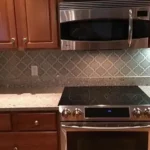In 2023, the Formica® Corporation marks a significant milestone: its 110th anniversary. For over a century, Formica® has consistently pushed the boundaries of creative design and functional innovation. This iconic brand has gained widespread recognition not only among Springfield, IL residents but also across the globe, known for its enduring, stylish surfaces that feature an extensive array of timeless patterns. At Ray’s Countertop Shop, Inc., we are proud to offer Formica® as one of our premium laminate countertop choices. Below, we will dive deeper into the progression of Formica® design throughout its remarkable 110-year history.
The Early Years
In its beginning in 1913, the Formica® Corporation was established by Daniel J. O’Connor, Herbert A. Faber, and John G. Tomlin, who joined forces to create the Formica Products Company. O’Connor initiated a patent application for a process aimed at producing laminated insulators. The original intention was to manufacture commutator V-rings, with laminate serving as a substitute for mica. Initially, the company focused on industrial laminate production. Their early patterns were characterized by a blend of simplicity and functionality, mirroring the prevailing industrial ethos of that era. More than just surface designs, these patterns conveyed a message of durability and practicality.
Mid-Century Modernism

As the mid-20th century started, Formica® enthusiastically embraced the design philosophy of the time. The era of mid-century modernism introduced a fresh aesthetic characterized by clean lines, vibrant colors, and geometric shapes. Notably, a laminate resistant to cigarette burns was developed, revolutionizing tabletops in popular cafes and restaurants. Industrial designer Brooks Stevens played a pivotal role by creating Formica Group’s inaugural graphic innovation—the Skylark pattern. Formica® patterns from this era became identical to the distinctive aesthetics of the 1950s and 1960s. Ranging from boomerangs to atomic motifs, these patterns decorated countertops and furniture, becoming an important element of the post-war American dream.
The Groovy 70’s
Entering the 1970s, Formica® patterns echoed the cultural shift towards assertive self-expression. The era embraced earthy tones, psychedelic swirls, and designs inspired by nature, creating a dominant aesthetic. Laminate countertops evolved into a canvas for artistic expression, infusing homes and commercial spaces with a distinct sense of individuality. The ’70s symbolized a celebration of uniqueness, with Formica® patterns playing a pivotal role in fostering that movement. In the late 1970s, the Formica Corporation established the Design Advisory Board (DAB), comprising influential architects and designers. Simultaneously, there was a notable development: the U.S. Federal Trade Commission (FTC) sought to cancel the Formica® brand trademark, asserting that the term “Formica” had become generic. This move triggered a significant reaction within the business community. Ultimately, the FTC’s action was abandoned, resolving the dispute.
Back to Basics in the 80’s

At the beginning of the 1980s, a resurgence of muted and neutral tones emerged. Formica® patterns mirrored a yearning for sophistication and simplicity, departing from the enthusiastic colors of the preceding decade. Classic wood grains and subtle textures gained popularity, indicating a shift toward a more timeless and enduring aesthetic. During this period, the company introduced ColorCore®, Formica Group’s patented through-color laminate line. In the late 1980s, Formica® honored its 75th anniversary by publishing the book “Formica and Design: From the Countertop to High Art” authored by Susan Grant Lewin. This publication provided a retrospective look at the brand’s journey, capturing its evolution from kitchen countertops to a form of high art.
Contemporary Elegance
In the 21st century, Formica® has not only evolved but thrived by staying attuned to the dynamic preferences of both designers and consumers. Its contemporary patterns seamlessly weave together technology, sustainability, and aesthetics, offering a diverse range of options. From high-definition prints that artfully mimic natural materials to eco-friendly alternatives, Formica® stands as a pioneer in ongoing design innovation. A significant milestone was reached in 2012 when Formica Group became the world’s first laminate manufacturer to be honored with the Carbon Trust’s Carbon Reduction Label. The brand’s commitment to sustainability and design excellence concluded in the celebration of its 100th anniversary in 2013, marked by the publication of the book “Formica Forever,” encapsulating a century of design and innovation.
Get in Touch with Ray’s Countertop Shop, Inc.
As we commemorate 110 years of Formica® patterns, it is evident that this brand has played a pivotal role in shaping the visual narrative of our living spaces. Originating as an industrial laminate manufacturer, Formica® has risen to the status of a design icon, demonstrating the enduring nature of good design. In reflecting on these 110 years, Formica® revisits the narratives behind some of its most unique historical patterns. Monthly, new stories unfold on their website, offering insights into the evolution of these iconic designs. If you’re considering Formica® countertops for your home in Springfield, IL, connect with our experts at Ray’s Countertop Shop, Inc. Explore our diverse range of laminate countertop options and contact us today by calling 217.483.2514 to have one of our specialists guide you through the many choices available.







